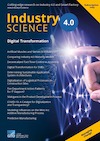Search


Bibtex
Cite as text
@Article{Pruhs+Kusch+Bertagnolli+Viere+Woidasky,
Cite-key = "Pruhs2023Maki",
Year= "2023",
Number= "1",
Volume= "Industry 4.0 Science 39",
Pages= "64-71",
Journal = "Industry 4.0 Science",
Title= "Makigami in the Product Development Process – Using a Lean Methodology to Integrate Sustainable and Circular Product Design",
Author= "Annika Pruhs, Anina Kusch, Frank Bertagnolli, Tobias Viere and Jörg Woidasky, Institute for Industrial Ecology, Pforzheim University of Applied Sciences",
Doi= "https://doi.org/10.30844/I4SE.23.1.64",
Abstract= "In order to implement future improvements in circular product properties such as lifespan extension, continued use or high-quality recycling, industrial product development and design processes must take the entire
ecological and economic life cycle of products into account. This article uses a company example to explain how such processes can be documented and analyzed using the Makigami method to support a comprehensive “Design for Circularity” concept. The chosen approach facilitates the
identification of the application points of circular design decisions and the implementation of validated circular economy principles.",
Keywords= "lean method, makigami, circular economy, product development, circular product design, EU Directive 2009/125/EC, ecodesign approaches, environmentally friendly product design, eco-friendly product design, product carbon footprint",
}
Annika Pruhs, Anina Kusch, Frank Bertagnolli, Tobias Viere and Jörg Woidasky, Institute for Industrial Ecology, Pforzheim University of Applied Sciences(2023): Makigami in the Product Development Process – Using a Lean Methodology to Integrate Sustainable and Circular Product Design. Industry 4.0 Science 391(2023), S. 64-71. Online: https://doi.org/10.30844/I4SE.23.1.64 (Abgerufen 27.07.24)
Open Access
Abstract
Abstract
In order to implement future improvements in circular product properties such as lifespan extension, continued use or high-quality recycling, industrial product development and design processes must take the entire ecological and economic life cycle of products into account. This article uses a company example to explain how such processes can be documented and analyzed using the Makigami method to support a comprehensive “Design for Circularity” concept. The chosen approach facilitates the identification of the application points of circular design decisions and the implementation of validated circular economy principles.
Keywords
Schlüsselwörter
lean method, makigami, circular economy, product development, circular product design, EU Directive 2009/125/EC, ecodesign approaches, environmentally friendly product design, eco-friendly product design, product carbon footprint
References
Referenzen
[1] Scholz, U.; Pastoors, S.; Becker, J. H.; Hofmann, D.; van Dun, R.: Praxishandbuch Nachhaltige Produktentwicklung. Berlin Heidelberg 2018.
[2] Molzbichler, K.: Nachhaltiges Design und User Experience – Digitale Transformation und die Auswirkungen der Gestaltung auf Mensch und Umwelt. In: oekom, Hochschulschriften zur Nachhaltigkeit 2019, p. 82.
[3] Buchert, T.; Neugebauer, S.; Schenker, S.; Lindow, K.; Stark, R.: Multi-criteria Decision Making as a Tool for Sustainable Product Development – Benefits and Obstacles. In: Procedia CIRP 26 (2015), pp. 70-75.
[4] Bertagnolli, F.: Lean Management – Introduction and In-Depth Study of Japanese Management Philosophy, 2nd Edition. Berlin 2022, pp. 224-225.
[5] Engeln, W.: Methoden der Produktentwicklung. München 2006, p. 18.
[6] Widmann, U.; Weissinger, J.; Breitling, T.; Hackenberg, U.; Wundram, K.; Goß, S.: Produktentstehungsprozess. In: Pischinger, S.; Seiffert, U. (ed): Vieweg Handbuch Kraftfahrzeugtechnik, 9th Edition. Wiesbaden 2021.
[7] Lashin, G.; Stark, R.: Virtuelle Produktentwicklung. In: Bender, B.; Gericke, K. (Hrsg): Pahl/Beitz Konstruktionslehre – Methoden und Anwendung erfolgreicher Produktentwicklung, 9th Edition.Berlin Heidelberg 2021.
[8] Kamp Albæk, J.; Shahbazi, S.; McAloone, T. C.; Pigosso, D. C. A.: Circularity Evaluation of Alternative Concepts During Early Product Design and Development. In: Sustainability 12 (2020) 22, p. 9353.
[9] van Doorsselaer, K.: The role of ecodesign in the circular economy. In: Circular Economy and Sustainability (2022), pp. 189-205.
[10] Europäische Kommission: Proposal for a REGULATION OF THE EUROPEAN PARLIAMENT AND OF THE COUNCIL establishing a framework for setting ecodesign requirements for sustainable products and repealing Directive 2009/125/EC. 2022.
[11] Babiceanu, R. F.; Seker, R.: Big Data and virtualization for manufacturing cyber-physical systems: A survey of the current status and future outlook. In: Computers in Industry 2016 (81), pp. 128-137. [12] World Economic Forum, Ellen MacArthur Foundation: Intelligent assets – Unlocking the circular economy potential (2016).

 English
English